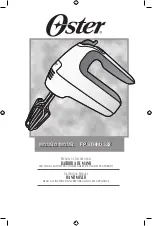
| 22 |
EN
2
Safety Instructions
WARNING
Read all the safety instructions and precautions.
Failure to observe the safety instructions and
precautions can cause serious injuries.
Keep all safety instructions and precautions for
future reference.
The term “power tool” used in the safety instructions
refers to mains-operated power tools (with mains
power lead) and battery-operated power tools
(without mains power cable).
2.1 Workplace safety
a) Keep your work area clean and well
illuminated.
Untidiness and unlit work areas can result in
accidents.
b) Never use the power tool in potentially
explosive environments containing flammable
liquids, gases or dusts.
Power tools generate sparks which can ignite
dust or vapours.
c) Keep children and other persons away from
the power tool during use.
A moment’s distraction can cause you to lose
control of the machine.
2.2 Electrical safety
a) The connecting plug of the power tool must fit
in the plug socket. The plug must not be mod-
ified in any way. Do not use adapter plugs in
conjunction with power tools with protective
earth conductor.
Unmodified plugs and properly fitting plug sockets
reduce the risk of electric shock.
b) Avoid physical contact with earthed surfaces
such as pipes, heaters, cookers and
refrigerators.
There is an increased risk of an electric shock if
your body is earthed.
c) Keep power tools away from rain and
moisture.
The ingress of water into a power tool increases
the risk of an electric shock.
d) Do misuse the cable in any way by using it
to carry or hang up the power tool or to pull
the plug out of the socket. Keep the cable
away from heat, oil, sharp edges and moving
machine parts.
Damaged or kinked cables increase the risk of an
electric shock.
e) When working with a power tool outdoors,
use only extension leads that are suitable for
outdoor use.
Use of an extension lead suitable for outdoor use
reduces the risk of electric shock.
f) If the use of the power tool in a damp environ-
ment is unavoidable, use a residual-current
circuit breaker.
Use of a residual-current circuit breaker (RCCB
with 10 mA maximum tripping current) reduces
the risk of an electric shock.
2.3 Safety of people
a) Always work carefully, attentively and sensi-
bly when using a power tool. Do not use the
power tools if you are tired or are under the
influence of drugs, alcohol or medication.
A moment of inattention while using the power
tool can result in serious injuries.
b) Wear personal protective equipment and
always wear goggles.
The wearing of personal protective equipment,
such as dust mask, non-slip safety shoes, helmet
or ear protectors, depending on the type and
application of the power tools, reduces the risk
of injuries.
c) Avoid accidental switching on of the power
tool. Ensure that the power tool is switched
off before connecting it to the mains power
supply and/or connecting the battery and
before picking up or carrying the tool.
If you have your finger on the switch when carry-
ing the power tool or you connect the tool to the
power supply when it is switched on, this can lead
to accidents.
d) Remove the adjusting tools or wrenches
before switching on the power tool.
A tool or wrench in a rotating part of the tool can
result in injuries.
e) Avoid abnormal postures when working.
Ensure you are standing firmly and maintain
your balance at all times.
This will enable you to control the power tool bet-
ter in unexpected situations.
Summary of Contents for BSM 270
Page 3: ...3 1 BSM 270 2 3...
Page 4: ...4 DE 5 4 BSM 288 6 DE minimale Drehzahl maximale Drehzahl EN minimum speed maximum speed...
Page 5: ...5 8 7 BSM 2868 110 V 230 V...
Page 6: ...6 DE 9 BSM 2842 BSM 2882 10...
Page 7: ...7 11 DE minimale Drehzahl maximale Drehzahl EN minimum speed maximum speed 12...











































